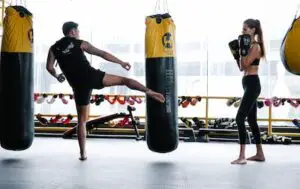Jiu-jitsu is a grappling martial art that has gained popularity in recent years because of its effectiveness in self-defense and sport competition. One of the essential skills in jiu-jitsu is takedowns, which is the act of taking an opponent down to the ground. The ability to perform a takedown successfully can make a significant difference in a jiu-jitsu match. This article will explore six sub-questions on how to improve takedowns in jiu-jitsu.
What are the types of takedowns in jiu-jitsu?
There are many types of takedowns in jiu-jitsu, but they can generally be grouped into two categories: throws and trips. Throws involve lifting and throwing the opponent to the ground, while trips involve sweeping the opponent’s legs out from under them. Some of the most common throws in jiu-jitsu include the hip throw (ogoshi), shoulder throw (seoinage), and foot sweep (osotogari). Some of the most common trips in jiu-jitsu include the outside trip (kosotogake) and inside trip (ouchigari).
What are the fundamentals of performing a takedown?
To perform a takedown successfully, there are a few critical fundamentals to keep in mind. First, you need to maintain a good base and balance. This means keeping your feet shoulder-width apart, your weight centered over your legs, and your hands up to protect your face. Second, you need to control your opponent’s balance. This can be done by breaking their posture, pulling them off-balance, or pushing and pulling them in different directions. Finally, you need to execute the takedown with speed and precision. This means committing fully to the takedown, using your entire body to push, pull, or lift your opponent, and following through to the ground.
How can you increase your takedown success rate?
There are several ways to increase your takedown success rate in jiu-jitsu. First, you need to practice your takedowns regularly. This means drilling the techniques with a partner, repeating them until they become second nature, and experimenting with different setups and combinations. Second, you need to improve your timing and footwork. This means learning to read your opponent’s movement, setting up your takedowns with fakes or feints, and moving smoothly and fluidly around the mat. Third, you need to be patient and persistent. This means not getting frustrated if your takedowns fail and continuing to work on them even when you face resistance or counterattacks.
How can you improve your takedowns throughout a jiu-jitsu match?
Improving your takedowns throughout a jiu-jitsu match requires a combination of technique, strategy, and mindset. First, you need to conserve your energy and avoid telegraphing your takedowns. This means staying relaxed, using your footwork to create angles and openings, and alternating between high and low attacks. Second, you need to be unpredictable and adaptable. This means switching between throws and trips, combining takedowns with submissions or sweeps, and changing your attack based on your opponent’s reaction. Finally, you need to stay confident and focused. This means visualizing yourself performing the takedown successfully, staying calm under pressure, and keeping a positive attitude even if you fail.
How can you overcome an opponent’s defensive takedown posture?
Overcoming an opponent’s defensive takedown posture requires a combination of technique, strategy, and timing. First, you need to create openings in your opponent’s defense. This means using fakes, feints, and misdirection to distract your opponent and set up your attack. Second, you need to change levels and use your body weight to break your opponent’s posture. This means getting low, using your hips to bump your opponent off-balance, and using your arms to pull or push their upper body. Third, you need to be patient and persistent. This means not getting discouraged if your first attempt fails, continuing to probe for openings, and being prepared to switch your attack if necessary.
What are some training strategies for improving your takedown skills?
There are several training strategies you can use to improve your takedown skills in jiu-jitsu. First, you need to drill the technique repeatedly until it becomes second nature. This means practicing the takedown with a partner, using both slow and fast repetitions, and experimenting with different variations. Second, you need to spar with opponents of varying skill levels. This means testing your takedowns against different body types, styles, and experience levels, and learning to adapt to different situations. Third, you need to cross-train in other martial arts that emphasize takedowns. This means learning from wrestling, judo, or sambo practitioners, and incorporating their techniques into your jiu-jitsu game. Finally, you need to watch and learn from instructional videos and matches. This means studying the techniques, strategies, and tactics used by top-level jiu-jitsu players and applying them to your own training.
Conclusion
In conclusion, mastering takedowns in jiu-jitsu requires practice, patience, and persistence. By understanding the types of takedowns, the fundamentals of executing them, and the strategies for improving them, you can improve your takedown skills and become a more well-rounded jiu-jitsu practitioner. Whether you are training for self-defense or sport competition, takedowns can give you a significant advantage on the mat and help you achieve your goals.





